How Angry Birds 2 increased revenue several times over the year
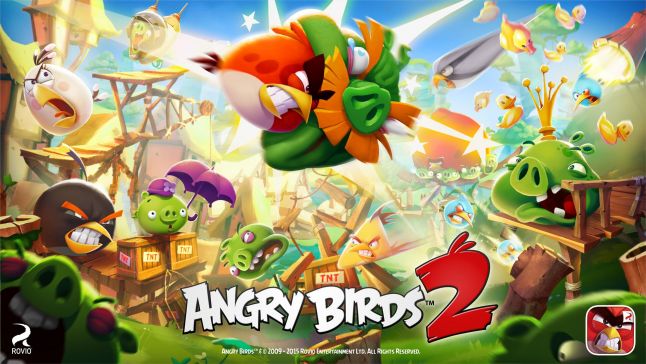
After the release of Angry Birds 2 at the end of July 2015, the game received mixed reviews. Both Pocket Gamer and IGN praised the game for its excellent graphics and significantly improved level design, but Rovio was reproached for the mechanics of life in the Candy Crush style and random levels.
"Ever-changing levels and a limited number of lives greatly spoil the pleasure of fighting pigs."
- From the review of Angry Birds 2 on IGN
')
If you look at the downloads, the release of Angry Birds 2 has become a huge success. By the end of 2015, the game almost reached the milestone of 50 million downloads. However, in terms of income, everything looked much darker: the game earned "only" about 10 million dollars.

After the first release, Angry Birds 2 began to decline, and for several months it had consistently low incomes. Growth was achieved thanks to the release of several important functions, built one above the other. After the release of the game there were no significant peaks of installations, which meant a steady increase in income. In addition to the release of important features, new levels have been added to the game.
Instead of setting a course for simply adding levels, the Stockholm-based developer Angry Birds 2 set to work. The 2016 updates have added a few basic mechanics to the game, such as raising birds and slingshots, daily quests and a PvP arena. At the same time, new levels of content were steadily and gradually added.
With each update, the game’s revenues took new heights and did not drop to previous lows. Today, Angry Birds 2 is constantly on the list of the top 50 in terms of revenue, and this is all only due to high-quality updates that have successfully added elements of games of medium complexity (mid-core) to the super-casual game.
History and my experience monetizing Angry Birds
Once upon a time (and by the standards of mobile games, a very long time ago) my powerful team of six people took on a difficult task. We wanted to show that we can turn Angry Birds from a classic paid game into free-to-play. We believed that in doing so, we would not only increase the game’s revenues, but also increase the engagement and retention rates of users.
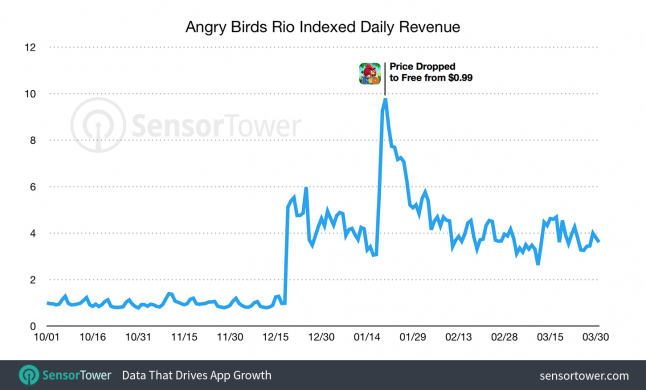
I argued that by turning a paid game into a free one, we would increase revenues and involvement. The team agreed with my arguments, making three important changes, which led to a steady increase in revenue.
In 2012, the transition to the free-to-play model was considered a revolutionary feat in Rovio. Paid games such as Angry Birds Space and Angry Birds Star Wars already in the week of release approached tens of millions of dollars in revenues, and the only free-to-play game, Angry Birds Friends, provided solid weekly earnings, although it is very inefficient for such KPI as income on daily active players. In other words, in 2012, everything was better nowhere and no one wanted to change the working formula.
“One dollar per game is enough. We don't want to be like Zynga. ”
- former first vice president of games for Rovio
In the middle of 2012, new games appeared. The first CSR Racing game ( here you can read the CSR analysis) of Natural Motion's company broke all income records. Then Supercell, located just a few kilometers from the Rovio office, released Clash of Clans (game analysis can be read here ) and Hay Day ( Hay Day analysis ), which instantly climbed to the top of the profitability lists and stayed there for 5 years (!!!). The combination of new free-to-play super-profit hits and unexpectedly bad Bad Piggies sales from Angry Birds Space 2 changed the attitude of the management and allowed my team to experiment with free-to-play mechanics.
Not to mention that six representatives of the Angry Birds franchise, for each of which individual teams released about 30 levels each month, were essentially unprofitable, because the games to which levels were added did not give any monetization, except for the price of one dollar that buyers paid years ago.
Thanks to all this, my team of six people gave the go-ahead to experiment with Angry Birds Rio , so that we could increase retention, involvement and monetization without harming ratings and fans. Our approach to solving these problems was simple. And he could not be otherwise, because with such limited resources there might not have been much.

The replay value of each level increased due to the introduction of levels with restriction on stars. Suddenly, earning more stars became important, because with them you could open new levels.
To begin with, we increased the replayability of levels. We knew that the players first wanted new levels, but they were a bottleneck of production. The creation of the level needed a whole day, and the players passed it in a couple of minutes.
The solution was to add a skill level. Earning stars, players could unlock special levels with a limit on stars. For each episode of 30 levels, we added only 3 additional “star” levels, which the player could unlock by typing 30, 60 and 90 stars. In other words, we encouraged the player to replay the levels to get all three stars.

By causing players to strive for more stars, we introduced boosters into the game, making it easier to get the desired stars.
Secondly, we added the monetization mechanics. By introducing a skill limit and motivating players to complete all levels with three stars, we added four different boosters. Create demand, and then provide a solution. We were not allowed to use the mechanics of lives. She was considered too punishing a player mechanics. Rovio has always been and remains a company run by game fans, putting their consumers' interests higher than short-term gains.
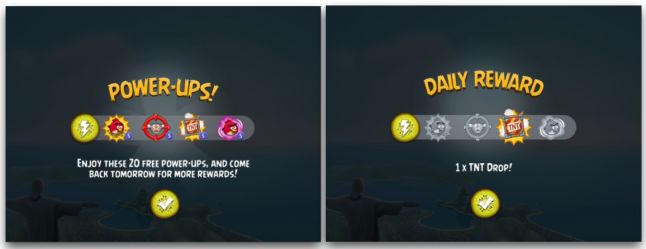
Finally, we added a gradual gain of boosters, which increased retention and conversion.
Third, we added a daily bonus to increase retention and allow players to experiment with boosters. The daily bonus was a simple roulette that rewarded the player with one of four boosters.
This simple update, combined with the transition from a paid to a free distribution scheme of the game, led Angry Birds to the top of the list of the most downloaded games, and then allowed to rise to the top 100 in terms of income. Increasing the number of installations led to an expansion of the player base, and this, in turn, increased advertising revenue. The update was successful and all these simple but effective solutions began to be applied in all Angry Birds games on mobile devices.
So what's new in Angry Birds 2?
Some were skeptical of the number in the name of the game. And this is understandable, because when you play it for the first time, it is very similar to the classic Angry Birds. You have a slingshot, different birds and pigs. What is new in the game?
Those who stayed longer in the game than the first 20 levels understand that the game really deserves the number "2".

Angry Birds 2 not only looks better, it has multistage randomized levels. The figure above shows the same level with different attempts. As you can see, the design of the house of pigs is changing.
The first and most obvious is that the graphics and the whole UX are significantly improved. For example, when a player puts a bird in a slingshot and stretches it, an enlarged image of the bird in the slingshot appears. And when a player aims at a pig, an image of a pig trembling in fear appears. Oh, and fast forward mechanics, which should be in all Angry Birds games.
Secondly, the levels of Angry Birds 2 have several stages . Instead of destroying a single pig house per level, a player destroys several houses in a row. This remarkable design change is combined with the mechanics of the bird cards (Bird Cards), in which the player does not see all the birds that he will have in the level, and instead draws new ones in the process of passing. This mechanics makes the levels more interesting, because you do not know what kind of house will be next and what birds will solve the tasks. The choice of which bird to use and which one to leave for later, in my opinion, makes the levels more attractive.
Thirdly, the levels are randomized to a certain limit . When you restart the level of construction will be different from previous ones. This significant improvement allows you to dynamically adjust levels. Theoretically, if a player passes levels too quickly, the constructions should become more difficult for the player to replay levels or pay for boosters and additional birds. Dynamically customizable levels and the ability to customize them based on player behavior are important features of King and the “secret ingredient” of its games.
Fourthly, Angry Birds 2 adds various ways of passing, which in turn, create different currencies and “funnels” of attracting players .
The player has an account level that grows when a player gets stars for completing levels. Account level is used as a limiter for functions such as daily quests, daily tasks and arena mode. Account level motivates the player to replay the levels, trying to achieve three stars.

In the game you can improve any bird, you just need to dial the appropriate colored feathers. A bunch of colored feathers.
In addition, there are birds, the level of which a player can raise by collecting various colored feathers found in chests. Increasing the level of birds increases the number of points of damage caused by the attack. Points not only allow you to achieve the desired three-star rating, but also to get an additional bird. At each level there is a strip of energy that is filled based on the damage points caused by the player. After filling the strip, the player receives another bird card. Brilliant!

Players can increase the level of the slingshot by collecting a collection of hats. Improved slingshot provides more damage points.
In Angry Birds 2, the player can raise the level of the slingshot itself . To increase the level of the slingshot, the player must first unlock all the birds, which requires passing through 44 levels. Then he should buy hats for each of the birds. Hats are bought on black pearls (Black Pearls), which can be found in chests. There are several different hats for each bird, which makes the collection very repeatable, that is, it increases the need for black pearls.

In Angry Birds 2, players can send gifts to each other. It sounds boring, but in fact this mechanism is well implemented. To send a gift, the player must first find it on the level and catch it with a bird. That is, he has to work for a prize that he cannot keep for himself. This kind of donation makes him feel generous.
And finally, the game has social features . By connecting the game to your Facebook account, you will see all your playing friends on the King-style map, as well as the leaderboards for each level. In addition, there are gifts to friends that players collect at the level and send to friends. However, players can not give life, it would have a bad effect on performance.
If you look at the detailed list of new features and compare it with the classic games of Angry Birds, it is clear that it is more than worthy of the number "2". The game looks better, plays better, offers a wide range of completely new features and game modes. But most importantly, Angry Birds 2 is monetized as one of the best-in-class puzzle games .
Monetization Mechanics 1 - Special Currency
In Angry Birds, instead of direct sales, we use our own currency in the form of jewels (Gems). As most know, own currency is more profitable than direct sales for four important reasons:
1. Own currency increases retention rates. When a player is motivated to buy more currency than he needs, it creates a “money in the bank” situation. This motivates them to return to the game, because they have the currency they paid for.
2. The currency increases the size of the average purchase. Simply increase the minimum price and add discounts for the volume of purchases - voila, you have increased the average income per paying user.
3. Own currency allows you to effectively use the motivated viewing of video advertising. After introducing your own currency into the game, you can use the gradual receipt of funds to motivate players to perform various tasks. Tournaments, missions, daily bonuses, tasks, and so on. By giving players the opportunity to get something that is worth real money, you increase retention, and sometimes stimulate conversion.
4. Domestic currency allows the player to get the most from the game when there is no network connection . Suppose a user is in an airplane. Most likely, he will have more time to play than five lives allow. Then he can replenish the currency in advance and buy life without connecting to the network.
In Angry Birds 2 there are several powerful funnels that increase the demand for jewelry. Demand is met at the jewelery store, which is perfect in Angry Birds. The store has 9 different packages of jewelry, from 99 cents to 99 dollars. Usually offers in stores are arranged in turn, from the cheapest to the most expensive. Prices are set in such a way that the player is motivated to buy either the most expensive or the second most expensive item. In Angry Birds 2, this feature is implemented, and even more.

Even the store in Angry Birds 2 is completely thought out. After each purchase of jewels, the player receives VIP points (marks) that allow you to purchase additional rewards. This feature increases both the number of repeat purchases and the volume of purchases.
Firstly, with each purchase, the player receives marks, that is, VIP points that give the player a bonus for the purchase. This stimulates the player not only to choose large packages of jewels, but also to make repeated purchases to increase VIP-status. Secondly, the game offers an automatic subscription to purchases, in which the player receives jewelry every day for a month. This is a great package to increase player retention with conversion.
Monetization Mechanics 2 - Life
In Angry Birds 2 there is a classic mechanics of lives. After each loss at the level of the player loses a life. In total, the player has five lives. Having lost all lives, he either has to wait until lives are replenished (at a rate of one life in 30 minutes), or pay to instantly fill lives.
The mechanics of lives are not only good monetization mechanics that monetize long gaming sessions, but also high-quality hold mechanics. After recovering lives, the player is pushed back into the game.

Life - the first and main mechanics of retention. With every loss a player loses a life. After losing all five lives, he must either wait or pay for their completion.
Personally, I believe that Angry Birds 2 can increase the efficiency of this mechanics by increasing the difficulty levels. Maybe I'm a very good player in Angry Birds, but after 50 levels I have almost no difficulty. Increasing the number of losses at the level can reduce the speed of player advancement through content and increase involvement, because players will play several times a day and be monetized by making up for lives.
Let me explain: I do not propose to increase the overall complexity. Rather, some blocking “boss levels” need to be made even harder for the cohort of players that is playing the game at a speed greater than average. I understand that low complexity in the early stages of the game leads to increased retention in the medium term.
However, in general, life traditionally does not stimulate monetization in puzzle games. This is more of a retention mechanic, limiting the duration of sessions and creating a prolonged incentive to return to the game. In addition, complexity at early levels may be lower in order to attract players. They need several “blocking” levels, showing that the game is difficult, but I have seen enough AB-tests of difficulty and now I know that a simple start of the game = better retention after 14 days (14D).
Monetization Mechanics 3 - Extra Turn
The mechanics of the extra turn is a saving parachute for players who are close to losing. This feature usually stimulates most of the monetization in the Saga game series. Monetization of additional moves stimulates the creation of levels with frequent situations "a little bit was not enough."
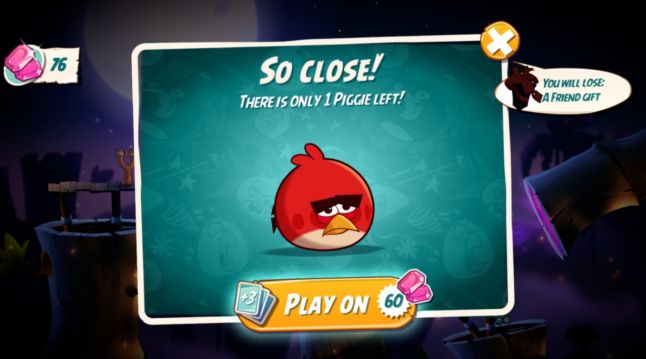
Puzzle games are monetized using additional moves. A player is so close to passing a level that he may even be willing to pay to end him.
Imagine a few sessions trying to complete a level. You are almost winning and sending the last bird to the king of pigs and you see that you didn’t hit him a little bit. At this stage, the game offers to give you a few more birds and continue the level in order to pass it with a high probability.
This is another function that can give much better results if the game uses the dynamic tuning function correctly. By segmenting players by speed and degree of completion of the game, you can provide the most enthusiastic players with much more difficult levels. Such enthusiastic players will start to lose more often, and therefore will use not only the completion of lives, but also the function of continuing the game to win in difficult levels.
Monetization Mechanics 4 - Chests and Advertising
As I said above, in Angry Birds 2 there are several progress trees, each of which uses its own currency. These currencies can be earned by opening the chests. The player receives a free chest every 30 minutes. In each chest there are five cards that are turned upside down when opening a chest. The player chooses one of the cards, which turns over with the rest. He can buy more valuable treasure chests or watch commercials to open more standard chests.

In Angry Birds 2 there are three types of chests. When opened, each chest shows the player 5 cards, of which the player chooses one. Advertising is associated with free chests and allows you to open several chests, if the player will view the ads between them.
The design of this function is very reliable, although I do not think that it is monetized as it could. First, the player is given free chests every 30 minutes, which, in my opinion, too often. Secondly, the contents of the chests are interesting, but in fact not very necessary. Raising the levels of birds and slingshot is not very useful if the player does not participate in the arena mode. If you increase the complexity of the levels and reduce the points of damage caused, then the players will have a need for feathers and black pearls, which can be found in chests. Let me remind you, they are needed to increase the level of slingshot and birds.
Monetization Mechanics 5 - Arena
Every 3 hours, the player receives a ticket allowing him to enter the arena. In the arena, the player meets face to face with other players in an asynchronous battle in Angry Birds. The player who caused the most damage points wins the battle.
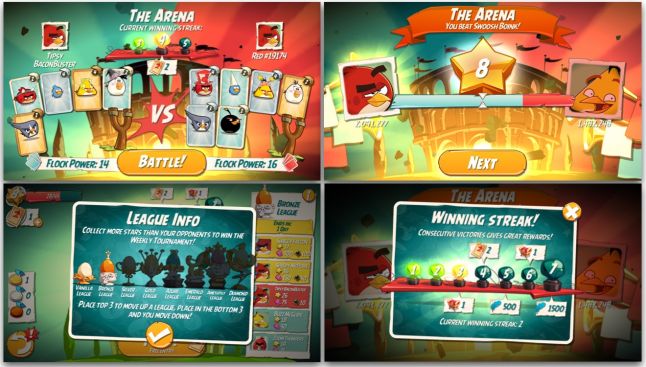
The arena mode is similar to any other game in Angry Birds 2. He has his own energy, tickets, a series win feature that rewards consecutive wins, and a league structure that creates a sense of progress.
The basic gameplay of the arena is quite similar to the gameplay of the 2012 Angry Birds Friends game. The difference is that the arena is only one of the elements of Angry Birds and it is much better thought out and implemented.
Firstly, the tickets that are needed to play in the arena, significantly limit the number of games in the arena mode. This makes every fight much more meaningful. Losing a battle means that the player will have to wait another three hours to play again in the arena.
Secondly, the function of the series of victories pushes the user to win in the arena by awarding him for several victories in a row.
Thirdly, the league function gives a strong sense of progress and progress in the game. Leagues in Angry Birds 2 are implemented in a traditional and safe style. Player for a week is placed in the same grid with 15 other players. Each asynchronous battle gives the player up to 10 stars, depending on how much he has overtaken the enemy in points of damage. The three players who scored the most stars during the week move up to a higher league level, and the three players with the worst results go down to a league level. There are a total of 8 league levels, and because of the blocking in time, it will take at least seven weeks to reach the highest level. Simple, straightforward and working approach!
Tickets, series of victories and league stimulate involvement and prestige, which, in turn, increase monetization in five different ways:
- Players are monetized by buying tickets that are like life in arena mode. Due to the time structure of the leagues, the player is motivated to buy tickets in order to win the stars and to avoid lowering or to achieve a higher level.
- Users are monetized by purchasing additional birds when they run out in combat. The mechanics of the extra turn allows the player to buy three more random birds to continue to receive damage points.
- Players can use all their boosters to increase damage points and defeat opponents. Boosters can be bought in boxes, and not directly, as in other Angry Birds games. This makes them more valuable.
- And finally, the player can get more damage points, increasing the level of birds and slingshots. In this way, the arena mode is tied to the basic mechanics of passing, because the player is motivated to receive or buy additional boxes and collect feathers and black pearls.
In my opinion, the arena is the most powerful function of Angry Birds 2 in terms of increased involvement and monetization.
The arena is interesting, it provides progress and monetizes, forcing players to compete. In addition, the arena is a real pay-to-win, because players can ensure their victory by buying birds and using boosters. But you know, for super casual players in Angry Birds, this is not important.
Monetization Mechanics 6 - spells
Spells are the same boosters added to Angry Birds Rio. The player can use spells at all levels, except for the most difficult levels with bosses. There are five different spells, from laser cannons to exploding chili peppers. The use of spells is quite boring, because they are automatic and do not require any skill. Although they look different, they differ little from each other functionally.
The most important is to use spells in the arena, where they help the player to win. This creates a pay-to-win effect, but I don’t think that the players in Angry Birds are concerned with fair play or balance.
Monetization Mechanics 7 - Tower of Luck
Fortune Tower is a daily bonus with the mechanics of gambling. Here's how it works: the player gets access to the fortune tower once a day. A visual display of this feature is an elevator stopping at each floor. At each stop, the player is shown four cards. Three cards are a reward that gets better with each floor, and one card is a pig that collects all the rewards earned before that. And in order to motivate the player to move on, there is a jackpot on every fifth floor without risk - there is no card with a pig in it.
In other words, this is an “all or nothing” game. If the player decides to choose a card, then he has a 75 percent chance of increasing the reward and a 25 percent chance of losing everything. Before choosing a card, the player has the opportunity to leave, taking with him all the awards received before.
 The tower of luck is, in essence, gambling mechanics. The player chooses one of the four cards. Three cards are bonuses, and one is a pig. As the level rises, the prize grows. Having pulled out the pig, the user finishes the game and takes away all the earned rewards from him, unless he pays in-game currency. This feature was added because of all the resources and lures in the game.
The tower of luck is, in essence, gambling mechanics. The player chooses one of the four cards. Three cards are bonuses, and one is a pig. As the level rises, the prize grows. Having pulled out the pig, the user finishes the game and takes away all the earned rewards from him, unless he pays in-game currency. This feature was added because of all the resources and lures in the game.How is the fortune tower monetized? Pretty simple. When a player turns the card over and finds a pig, he can either lose all the rewards he received to this floor, or pay with jewels to continue.With each selected pig, the cost of the continuation rises significantly. As you progress through the levels, the rewards are accumulated and the players are more likely to want to pay a larger amount than to lose all the rewards they collect.
Casual game with the mechanics of games of medium complexity (Mid-Core)
Casual games available. They usually attract a large number of daily active users, so they suffer from low income per player. There are also the so-called games of medium complexity (mid-core), which are less accessible, but much better monetized. The costs of attracting users have increased, and the mobile gaming market has become very saturated, so games with low monetization, and therefore low player value (LTV), have begun to use mid-core mechanics.
Angry Birds 2 is a best-in-class example of a casual game that has successfully applied traditional mechanics of average complexity. At the time of the release of the game, she looked like an improved version of the good old Angry Birds. However, when the initial installations were exhausted, the development team faced a cruel reality - LTV was too small to effectively attract users, and without a steady increase in downloads, the game was doomed to death.
The Stockholm development team of Angry Birds 2 set to work and created a steady stream of new features that methodically moved the game from gradual wilting to the top 50 best-performing games. So, ladies and gentlemen, there is progress and set new standards of the genre.
Source: https://habr.com/ru/post/333406/
All Articles